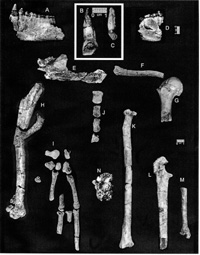
Although scientists believe the common ancestor of great apes and humans arose in the Miocene era 14 to 23 million years ago, study of the teeth and jaws of a hominid from that era by Yale anthropologists shows the animal was too primitive to be that "missing link."
|
provides insights into the origins of humans
Yale research of a partial ancient ape skeleton from more than 15 million years ago has yielded a new genus called Equatorius, providing evidence that the more likely ancestor of great apes and humans is a species called Kenyapithecus wickeri.
The origin of humans and great apes has never been clear, but past research shows that the lineage for both species most likely originated from one animal that lived during the Miocene era in central Kenya. This new study, published in the Aug. 27 issue of Science, lends greater support to the common ancestor theory.
The Baringo Paleontological Research Project compared the skeleton's teeth and jaws to two known Kenyapithecus species. The analysis showed a more primitive facial pattern in Kenyapithecus africanus, and a more modern, great-ape-like pattern in Kenyapithecus wickeri, leading researchers to place the more primitive-looking species in the new Equatorius genus.
By separating the more primitive Equatorius specimens from the Kenyapithecus sample, this study provides a clearer path for research that delves deeper into establishing how Kenyapithecus might fit into ape and human ancestry, according to Andrew Hill, professor of anthropology and the study's director.
"This new fossil is the only known skeleton in the world with associated teeth and limb bones from the Middle Miocene hominoid," says Hill. "Previous fossils consisted mostly of isolated teeth, which doesn't add much to the research. Our discovery confirms suspicions and theories that the two Kenyapithecus species belong to two different lines and should be given different names."
The research team also found a strong similarity between the dental patterns of Kenyapithecus wickeri and an unnamed ape species from the Middle Miocene site of Pasalar in Turkey. Observing the same anatomy in animals from separate parts of the world helped confirm the differences between Kenyapithecus wickeri and Equatorius.
The relationship between Equatorius and later apes is still uncertain, but the Equatorius genus is described as a stem hominoid, which is considered too primitive to be the direct ancestors of modern apes and humans. This study also places Equatorius on Earth 15 million years ago and Kenyapithecus 12 million years ago.
Yale's Baringo Paleontological Research Project began 20 years ago in Kenya's Baringo Basin. In 1994, the team discovered the skeleton used in this study and moved it to the National Museums of Kenya to begin research. The male fossil consists of a lower jaw with teeth, some upper incisors, and an unusual amount of skeletal material, including bones or parts of bones from the arm, shoulder, collarbone, chest, wrists and fingers, and vertebrae.
In addition to Hill, the research team included senior author Steve Ward of the Northeastern Ohio Universities College of Medicine and Kent State University; Barbara Brown of Northeastern Ohio Universities College of Medicine; Jay Kelley, University of Illinois at Chicago's College of Dentistry; and Will Downs of Northern Arizona University.
This study was funded by the National Science Foundation, the Louise Brown Foundation and J. Clayton Stephenson.
-- By Karen Peart
T H I S
Bulletin Home
 W E E K ' S
W E E K ' S S T O R I E S
S T O R I E S![]()
 Yale greets 'superb' crop of freshmen
Yale greets 'superb' crop of freshmen![]()
![]()
 Outreach to students is key goal of new assistant deans
Outreach to students is key goal of new assistant deans![]()
![]()
 Discovery of skeleton from ancient ape provides insights into the origins of humans
Discovery of skeleton from ancient ape provides insights into the origins of humans![]()
![]()
 Scientists get close-up look at interior of ribosomes
Scientists get close-up look at interior of ribosomes![]()
![]()
 Endowed Professorships
Endowed Professorships![]()
![]()
 Bosnians share traumatic war experiences with Yale chaplain
Bosnians share traumatic war experiences with Yale chaplain![]()
![]()
 Development Office reorganizes Major Gifts division
Development Office reorganizes Major Gifts division![]()
![]()
 FOCUS program gives students a close-up view of city
FOCUS program gives students a close-up view of city![]()
![]()
 Exhibit features abstract photographs of the natural world world
Exhibit features abstract photographs of the natural world world![]()
![]()
 School of Architecture exhibits explore 'cutting edge' arts
School of Architecture exhibits explore 'cutting edge' arts![]()
![]()
 While You Were Away ...
While You Were Away ...![]()
![]()
 In the News
In the News![]()
![]()
 Journalists will get in-depth look at law as Knight Fellows
Journalists will get in-depth look at law as Knight Fellows![]()
![]()
 Concert celebrates new year at the School of Music
Concert celebrates new year at the School of Music![]()
![]()
 Memorial service to be held for Julia Rusinek
Memorial service to be held for Julia Rusinek![]()
![]()
 Seven faculty members receive ASCAP awards
Seven faculty members receive ASCAP awards![]()
 |
| Visiting on Campus
Visiting on Campus |
| Calendar of Events
Calendar of Events |
| Bulletin Board
Bulletin Board![]()
Classified Ads |
| Search Archives
Search Archives |
| Production Schedule
Production Schedule |
| Bulletin Staff
Bulletin Staff![]()
Public Affairs Home |
| News Releases
News Releases |
| E-Mail Us
E-Mail Us |
| Yale Home Page
Yale Home Page